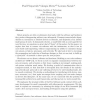Free Online Productivity Tools
i2Speak
i2Symbol
i2OCR
iTex2Img
iWeb2Print
iWeb2Shot
i2Type
iPdf2Split
iPdf2Merge
i2Bopomofo
i2Arabic
i2Style
i2Image
i2PDF
iLatex2Rtf
Sci2ools
RAS
2008
2008
Towards long-lived robot genes
Robot projects are often evolutionary dead ends, with the software and hardware they produce disappearing without trace afterwards. Common causes include dependencies on uncommon or obsolete devices or libraries, and dispersion of an already small group of users. In humanoid robotics, a small field with an avid appetite for novel devices, we experience a great deal of "churn" of this nature. In this paper, we explore how best to connect our software with the mainstream, so that it can be more stable and long-lasting, without compromising our ability to constantly change our sensors, actuators, processors, and networks. We also look at how to encourage the propagation and evolution of hardware designs, so that we can start to build up a "gene-pool" of material to draw upon for new projects. We advance on two fronts, software and hardware. Building on our robot software architecture YARP [11], we focus on how to organize communication between sensors, processors, and...
| Added | 28 Dec 2010 |
| Updated | 28 Dec 2010 |
| Type | Journal |
| Year | 2008 |
| Where | RAS |
| Authors | Paul M. Fitzpatrick, Giorgio Metta, Lorenzo Natale |
Comments (0)

